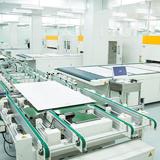

Glass screen printing inks sometimes have bubbles on the ink after printing. The main reasons for the generation of bubbles are as follows:
1. The substrate is poorly processed before printing. In order to remove these bubbles, an antifoaming agent is used, and the amount of the antifoaming agent in the ink is generally from about 0.1 to about 1%, and if it exceeds a predetermined amount, it will foam. Even if the ink is transferred after the transfer, as long as the wettability of the substrate and the fluidity of the ink are good, the bubbles on the surface of the printing ink film are gradually removed, and the glass screen printing ink forms a flat printing ink film. If the glass screen printing ink bubbles are not removed, the ink film forms an annular uneven surface. Generally, the bubbles in the glass screen printing ink can be defoamed by the action of the screen when passing through the screen;
2. Bubbles may also be generated if the printing speed is too fast or the printing speed is not uniform. The printing speed should be appropriately reduced to maintain the uniformity of the printing speed;
3. Electrostatic failure The electrostatic current is generally small, but the potential difference is very large, and one can attract, repel, conduct, discharge, etc.
4. The adverse effect on screen printing, the screen at the time of printing, the rubber portion and the screen are charged by the pressure scraping of the blade rubber. If the screen itself is charged, it will affect the normal inking and cause blockage failure; it will be sucked by the screen at the moment of the output of the substrate;
5. Methods to prevent static electricity, to prevent static electricity generation: adjust the ambient temperature, increase the air humidity, the appropriate temperature is generally about 20 ° C, relative humidity of about 60%; can make static electricity in the wet air; reduce the network distance , reduce the printing speed.
Gloss properties:
1. Printed on the instant baking to show flat ink;
2. Printed for 3 hours and then baked as a bright ink;
3. Add a little more diluent and bake it as a bright ink.
dry:
1. After adding 8:1 hardener, dry naturally, dry for 40-60 minutes; dry for 12-24 hours;
2. After adding 8:1 to 10:1 hardener, it can be baked at a low temperature of 80-120 degrees for 30 minutes, and if it is baked at 120-150 degrees for 10-30 minutes, its solvent resistance and paying power are better.
Printing method: silk screen, pad printing
Resistance:
1. After the ink is completely dried, the ink film exhibits a good paying force, alcohol resistance and abrasion resistance.
2. Because it can be baked and low-temperature baked, it is suitable for printing on materials such as reinforced acrylic, mobile phone lens, plastic plating surface, and plastic UV fuel injection surface.
3. For special materials, there are high requirements for alcohol resistance, sweat resistance, wear resistance and other products, such as machine metal knobs, anodized aluminum digital camera shells, glass cosmetic bottles, metal eye legs, etc., baking with 120-150 degrees 10- The effect is better after 30 minutes.
Scope of application: metal, electroplated surface, ceramic, painted surface, reinforced acrylic, hardened acrylic, UV spray surface, flame treated PP, PE, etc.; good adhesion to hard materials.
Tel:15158365810
HTML:www.mysyqc.com
Add:No.185, bridge 3 road, xiaoqiaotou village, qiaotou town, cixi city